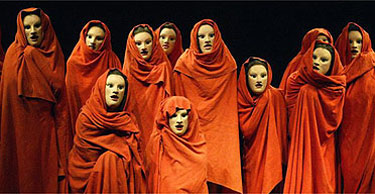
Originated by Sappho and defined by Pindar and Horace, the lengthy, lyrical ode features elaborate stanza structures and stateliness in tone and style.
For nearly three millennia, the ode has been one of the most elaborate and dignified poetic expressions ever developed. Originally created to provide choral accompaniment to musical instruments, the ode evolved into a lyric poem that praised and glorified individuals, accomplishments, and victories, while also painting observant portraits of nature.

The ode was patterned after the movements of the chorus in Greek drama.
| Rhyme: | Varied |
| Structure: | Unfixed number of four- to six-line stanzas |
| Measure/Beat: | Varied, but iambic tetrameter is most common |
| Common Themes: | Pindaric celebrates gods, events, experiences, other individuals; Horatian is deeply personal |
| Other Notes: |
|
